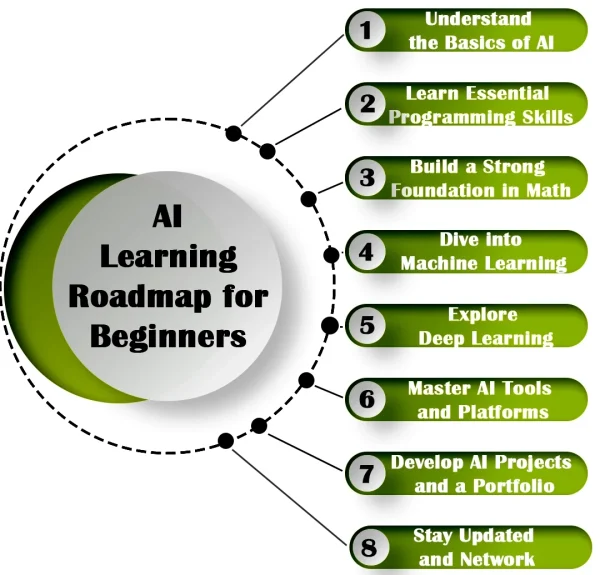AI Learning Roadmap for Beginners: Skills, Tools, and Techniques

Introduction
Table of Contents
Artificial Intelligence (AI) is no longer a futuristic concept; it is reshaping industries and impacting everyday life. Whether you want to build smart applications, analyze data more effectively, or understand the principles behind AI, starting with a structured roadmap can help you navigate this vast field. This article provides a comprehensive AI learning roadmap for beginners, focusing on essential skills, tools, and techniques to help you kickstart your AI journey.
Why Learn AI?
Before diving into the roadmap, let’s understand why learning AI is beneficial:
High Demand: AI professionals are in high demand across industries such as healthcare, finance, e-commerce, and technology.
Career Opportunities: From machine learning engineers to AI product managers, the career paths in AI are diverse and lucrative.
Problem-Solving Skills: AI equips you with tools to solve complex real-world problems.
Future-Proof Skills: As AI adoption grows, expertise in AI ensures you stay relevant in the job market.

Step 1: Understand the Basics of AI
Key Concepts to Learn
What is AI?
Definition and types (narrow AI, general AI, and super AI).
Core Domains of AI:
Machine Learning (ML)
Natural Language Processing (NLP)
Computer Vision
Robotics
Real-World Applications:
Virtual assistants, recommendation systems, and autonomous vehicles.
Suggested Resources
Books: “Artificial Intelligence: A Guide to Intelligent Systems” by Michael Negnevitsky.
Online Courses: Introduction to Artificial Intelligence on Coursera or edX.
YouTube Channels: AI-focused channels like 3Blue1Brown and Tech with Tim.
Step 2: Learn Essential Programming Skills
Python
Most popular language for AI development due to its simplicity and extensive libraries.
R
Great for statistical analysis and data visualization.
JavaScript
Useful for implementing AI in web applications.
Essential Libraries and Frameworks
NumPy and Pandas: For data manipulation.
Matplotlib and Seaborn: For data visualization.
TensorFlow and PyTorch: For building machine learning models.
How to Learn
Interactive Platforms: Codecademy, DataCamp, and LeetCode.
Books: “Python Crash Course” by Eric Matthes.
Step 3: Build a Strong Foundation in Mathematics
Key Topics
Linear Algebra
Vectors, matrices, and their operations.
Probability and Statistics
Bayes’ theorem, distributions, and hypothesis testing.
Calculus
Differentiation and integration for understanding optimization in ML models.
Recommended Resources
Books: “Mathematics for Machine Learning” by Deisenroth, Faisal, and Ong.
Online Tutorials: Khan Academy and Brilliant.org.
Step 4: Dive into Machine Learning
Key Topics to Master
Supervised Learning:
Regression and classification.
Unsupervised Learning:
Clustering and dimensionality reduction.
Reinforcement Learning:
Learning through interaction with environments.
Tools to Use
Scikit-learn: For building and evaluating machine learning models.
Google Colab: For running experiments in the cloud.
Practical Steps
Work on beginner projects like predicting house prices or building a recommendation system.
Join Kaggle competitions to apply your skills.
Step 5: Explore Deep Learning
Key Topics to Master
Neural Networks
Basics of perceptrons, activation functions, and architectures.
Convolutional Neural Networks (CNNs)
For image recognition tasks.
Recurrent Neural Networks (RNNs)
For sequential data like time series and text.
Tools and Frameworks
TensorFlow: Developed by Google for deep learning applications.
PyTorch: Preferred by researchers for its dynamic computation graph.
Suggested Projects
Build an image classifier using CNNs.
Create a chatbot using RNNs and NLP techniques.
Step 6: Master AI Tools and Platforms
Popular AI Platforms
Google AI Platform
Comprehensive tools for deploying AI solutions.
IBM Watson
For NLP and analytics.
Azure Machine Learning
Cloud-based AI solutions from Microsoft.
Learning Paths
Follow tutorials and official documentation.
Experiment with free-tier services to gain practical experience.
Step 7: Develop AI Projects and a Portfolio
Why Projects Are Important
Demonstrate your skills to potential employers.
Gain hands-on experience in solving real-world problems.
Project Ideas
Sentiment analysis of social media posts.
Automated email classification.
Predictive maintenance using IoT data.
Platforms for Hosting Projects
GitHub: Showcase your code and documentation.
Medium: Write about your learning journey and insights.
Step 8: Stay Updated and Network
Staying Updated
News Platforms:
Subscribe to AI blogs like Towards Data Science and OpenAI’s updates.
Communities:
Join forums like Reddit’s r/MachineLearning and Stack Overflow.
Networking Opportunities
Attend AI webinars and conferences.
Participate in hackathons and local meetups.
Conclusion
Learning AI as a beginner can seem daunting, but with a structured roadmap and the right resources, anyone can master this exciting field. Start by understanding the basics, build your programming and mathematical skills, and gradually explore advanced topics like machine learning and deep learning. By working on projects and staying updated, you’ll position yourself as a knowledgeable and skilled AI practitioner. Take the first step today, and unlock a world of opportunities in AI.
